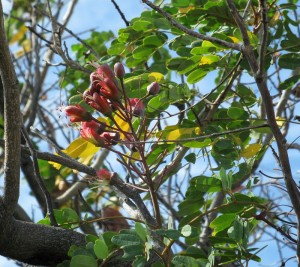Meeting Wednesday on Designating Habitat for Rare Plants
A federal agency will be holding a second public meeting Wednesday in Kailua-Kona on a proposal to designate nearly 19,000 acres on the Big Island as critical habitat for three plant species.
The meeting by the US Fish and Wildlife Service is scheduled from 3 to 5 p.m. at the West Hawaii Civic Center’s Community Meeting Hale, Building G.
The agency has also extended the public comment period on the proposal to Sept. 3.
A public meeting was previously held on the subject on May 15.
One of the three species, Bidens micrantha ssp. Ctenophylla, known by its Hawaiian name as ko‘oko‘olau, is among 15 species — 13 plants and two animals — found on the Big Island proposed for listing under the Endangered Species Act . Critical habitat has not been determined for the other 14.
The other two species that are the subject of the critical habitat proposal, Mezoneuron kavaiense or uhiuhi, and Isodendrion pyrifolium or wahine noho kula, are previously listed plant species that currently do not have designated critical habitat on the island of Hawai‘i.
The Fish and Wildlife Service said it is holding the additional public meeting and extending the comment period “to ensure that the public has an adequate opportunity to review and comment” on the proposal.
The agency said the designation is being proposed because habitat destruction and modification caused by invasive, nonnative plants, feral pigs, sheep and goats, and agricultural and urban development are considered a threat.

Uhiuhi is the third Hawaiian plant for which critical habitat has been proposed. Photo by C. Harrington/USFWS.
Other threats include consumption of rare species by nonnative feral pigs, sheep and goats, and other introduced species such as rats and nonnative invertebrates. Native habitat is also threatened by the effects of climate change, which may intensify existing natural threats such as fire, hurricanes, landslides and flooding.
Roughly 6,700 acres of the proposed critical habitat is in private ownership, while the rest is owned by the state.
“In the proposed rule, the service is considering excluding 4,099 acres of privately owned lands from critical habitat that have a voluntary conservation agreement, are partners in watershed partnerships or dry-forest working groups, or have a conservation or watershed preserve designation or similar conservation protection,” the agency said.
More information on the proposal is available here.














